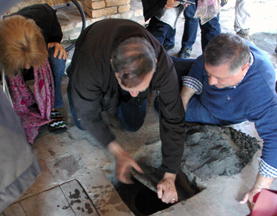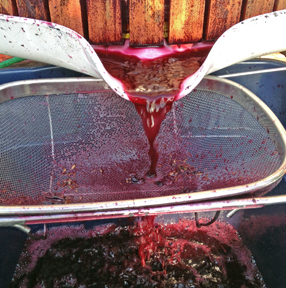I usually end the year reflecting on my New Year’s resolutions. However, we were so busy finishing our third book last New Year’s that I forgot to make winemaking resolutions for 2014. That didn’t stop us though. Kathy and I completed our seventh year of making wine. We started in 2008 when we determined that if we were going to write about wine, we should make wine.
The new year, 2014, started with several wines aging. We had a buried qvevri of wine at Twins Wine Cellar in Napareuli, Kakheti, Georgia. Even though Georgia was over 6,000 miles away, we were still interested in how it was going to turn out. We found out in April, when on a Media FAM trip at the International Wine Tourism Conference in Tbilisi, our media group went to Twins Wine Cellar and Kathy and I opened our qvevri. The wine was a clear dark gold color. We received several comments from the media group such as the best qvevri wine they had tasted. This experience of making qvevri wine, prompted us to return to Maryland with a qvevri, bury it and make a qvevri wine at home. Qvevri winemaking is the only winemaking process that is on the UNESCO list of Intangible Cultural Heritage.
Also at the beginning of the year we had a 2012 second run wine in carboys that should have been bottled during 2013. After finding space in the wine room, we bottled the two cases of this wine. There are pros and cons of making second run wines. I made it to learn how to make a second run wine and had low expectations on how it might turn out. My expectations were not even close to the way the wine turned out. The mostly Cabernet Sauvignon had an opaque dark purple color, with an aroma of black fruits. It was better than a daily table wine and I did serve it to guests. What I learned from the experience is that if you have a source of ultra-premium grapes, you can indeed make a pretty good second run wine. This prompted me to make another second run wine during 2014 with pomace from the 2014 wine we made with grapes from Stagecoach Vineyard in Napa Valley.
The third wine we had in barrel in January was at Tin Lizzie Wineworks in Maryland. This wine was bottled in August after spending 20 months in barrel. I would have liked to have kept it in barrel until October, but logistics of a custom crush facility came into play. The 2012 was a 100% Cabernet Sauvignon from Stagecoach Vineyard. Since we owned the two-year-old Taransuad French oak barrel, we decided to make another wine in it. We lucked out with 2014 being a fantastic year for Napa Valley grapes. We decided to make a blend of 75% Cabernet Sauvignon, 20% Merlot and 5% Petit Verdot.
The year 2014 was a rather full year of winemaking and bottling. We are anxious to see where we will head in 2015.
Cheers,
Terry





Leave a Reply